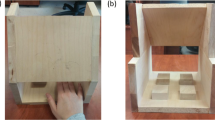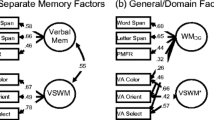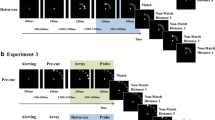Abstract
There is increasing evidence to support the idea that visuo–spatial working memory can be segregated into separate cognitive subsystems. However, the nature of these systems remains unclear. In this paper we report data from two brain injured patients suggesting that information about visual appearance is retained in a different subsystem from information about spatial location, and that this differential processing can be observed when the style of presentation (sequential or simultaneous) is controlled.
Similar content being viewed by others
References
Benton AL, Hamsher K, Varney N, Spreen O (1992) Unknown Faces Recognition Test : Italian Version: Organizzazioni Speciali, Firenze
Coltheart M, Davies M (2003) Inference and explanation in cognitive neuropsychology. Cortex 39:188–191
Courtney SM, Ungerleider LG, Keil K, Haxby JV (1996) Object and spatial visual working memory activate separate neural systems in human cortex. Cerebral Cortex 6:39–49
Della Sala S, Gray C, Baddeley A, Allamano N, Wilson L (1999) Pattern span: a tool for unwelding visuo–spatial memory. Neuropsychologia 37:1189–1199
S, Gray C, Baddeley AD, Wilson L (1997) The Visual Patterns Test: A New Test of Short Term Visual Recall. Thames Valley Test Company, Feltham
Dunn JC, Kirsner K (2003) What can we infer from double dissociations? Cortex 39:1–7
Gauthier L, Dahaut F, Joannette Y (1989) The Bells Test: a quantitative and qualitative test for visual neglect. Int J Clin Neuropsychol y 1:49–54
Goldenberg G (1995) Imitating gestures and manipulating a manikin – the representation of the human body in ideomotor apraxia. Neuropsychologia 33:63–72
Golding E (1989) Middlesex Elderly Assessment of Mental State (MEAMS). Thames Valley Test Company, Bury St. Edmunds
Logie RH (1995) Visuo–Spatial Working Memory. Lawrence Erlbaum Associates, Hove
Logie RH (2003) Spatial and visual working memory: a mental workspace In: Irwin DE, Ross BH (eds) The psychology of learning and motivation (volume 42): Cognitive Vision. Academic Press, New York, pp 37–78
Logie RH, Marchetti C (1991) Visuospatial working memory: visual, spatial or central executive? In: Logie RH, Denis M (eds) Mental images in human cognition. Elsevier, Amsterdam, pp 105–115
Pearson DG, Sahraie A (2003) Oculomotor control and the maintenance of spatially and temporally distributed events in visuo–spatial working memory. Q J Exp Psychol 56A:1089–1111
Postle BR, Idzikowski C, Della Sala S, Logie RH, Baddeley AD (in press) The selective distribution of spatial working memory with eye movements. Q J Exp Psychol
Service UDM (1990) Guide for use of the Uniform Data Set for Medical Rehabilitation including the Functional Independence Measure Version 3. 0. Uniform Data System for Medical Rehabilitation, The Buffalo General Hospital, Buffalo NY
Smyth MM, Pearson NA, Pendleton LR (1988) Movement and working memory: patterns and positions in space. Q J Exp Psychol 40A:497–514
Spinnler H, Tognoni G (1987) Standardizzazione e taratura italiana di test neuropsicologi. Ital J Neurol Sci 8(Suppl 6):1–20
Walter H, Bretschneider V, Grön G, Zurowski B, Wunderlich AP, Tomczak R, Spitzer M (2003) Evidence for quantitative domain dominance for verbal and spatial working memory in frontal and parietal cortex. Cortex 39:897–911
Author information
Authors and Affiliations
Rights and permissions
About this article
Cite this article
Darling, S., Della Sala, S., Logie, R.H. et al. Neuropsychological evidence for separating components of visuo–spatial working memory. J Neurol 253, 176–180 (2006). https://doi.org/10.1007/s00415-005-0944-3
Received:
Revised:
Accepted:
Published:
Issue Date:
DOI: https://doi.org/10.1007/s00415-005-0944-3




